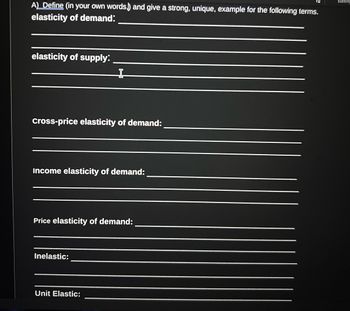
ENGR.ECONOMIC ANALYSIS
14th Edition
ISBN: 9780190931919
Author: NEWNAN
Publisher: Oxford University Press
expand_more
expand_more
format_list_bulleted
Question

Transcribed Image Text:Diminishing marginal utility:
Marginal utility per dollar:
I
Income effect:
Substitution effect:
Diseconomies of scale:
Explicit vs. implicit costs:
2
Editing

Transcribed Image Text:A) Define (in your own words,) and give a strong, unique, example for the following terms.
elasticity of demand:
elasticity of supply:
I
cross-price elasticity of demand:
Income elasticity of demand:
Price elasticity of demand:
Inelastic:
Unit Elastic:
Editing
Expert Solution
This question has been solved!
Explore an expertly crafted, step-by-step solution for a thorough understanding of key concepts.
Step by stepSolved in 2 steps

Knowledge Booster
Similar questions
- For each of the following cases, determine whether the firm should (A) Use more labor and less capital, or (B) Use more capital and less labor. 1. The marginal rate of technical substitution is 2 (i.e., the marginal product of labor is twice the marginal product of capital) and the input price ratio is 3 (i.e., a unit of labor costs three times as much as a unit of capital) 2. The marginal rate of technical substitution is 2 (i.e., the marginal product of labor is twice the marginal product of capital) and the input price ratio is 1 (i.e., a unit of labor costs the same as a unit of capital) 3. The marginal rate of technical substitution is initially equal to the input price ratio, but the firm's machines depreciate, so that the marginal product of capital decreases. 4. The marginal rate of technical substitution is initially equal to the input price ratio, but the firm successfully negotiates a lower rate of rent for their machines, so that the price of capital decreases. 5. The…arrow_forwardUncertain which options match each blank: a. Decreases, and therefore the curve shifts down b. Is unaffected, and therefore the curve does not shift c. Increases, and therefore the curve shifts uparrow_forwardThe marginal utility of additional units of a product tends to: Go up Go down Remain constant There is no marginal utility beyond the first unit.arrow_forward
- The activity driver for the packing activity is the number of packing hours. Product A uses 50 packing hours and Product B uses 150 packing hours. Calculate the consumption ratios for each product. Group of answer choices 0.3; 0.7 1; 3 0.25; 0.75 0.215; 0.785arrow_forwardPlease no written by hand and no image As producers increase their output, generally the factors of production will become less productive and therefore more costly for each additional unit. This explains the law of diminishing marginal utility income effect substitution effect law of supply law of demandarrow_forwardConstrained Optimization: Cobb-Douglas Production Function:1. Based from the factor shares of the two inputs, what will happen to the number of output if it the firm decides to triple both the amount of labor and capital?2. State the optimization problem of the firm.3. Solve for the formulas of the Marginal Product of Labor (MPL), and Marginal product ofCapital (MPK)4. Using your knowledge of the tangency condition in Producer’s theory, find the combinationof K and L that the firm should use to produce the maximum possible output. Do not solvethe problem using the Lagrangian method.Note: The tangency conditions just states that the slope of the production function must beequal to the slope of the isocost function.5. What is the maximum possible output that the firm could earn given the constraint it faces?arrow_forward
- Production. Assume a production with two variable inputs (L, K). Show graphically the following and explain: (a) fixed-proportions production function (b) inputs are perfect substitutesarrow_forwardExplain the logic behind the economist's quip that " there is no such thing as a free lunch."arrow_forwardPlease help me find the marginal rate of substitution.arrow_forward
- Macmillan Learning At your local family fun center, miniature golf is $12 per person for unlimited rounds in a day, while each go-kart session is $8. Given this information, calculate the cost of the following. Total cost of 0 rounds of golf: $ Total cost of 2 rounds of golf: $ Total cost of 0 go-kart sessions: $ Total cost of 2 go-kart sessions: $ 11 Total cost of 1 round of golf: $ Total cost of 3 rounds of golf: $ Total cost of 1 go-kart session: $ #00 Total cost of 3 go-kart sessions: $arrow_forwardThe slope of an isocost line measures Answer choices The marginal rate of technical substitution The marginal rate of substitution the optimal combination of inputs the ratio of the prices of the inputsarrow_forward
arrow_back_ios
arrow_forward_ios
Recommended textbooks for you

 Principles of Economics (12th Edition)EconomicsISBN:9780134078779Author:Karl E. Case, Ray C. Fair, Sharon E. OsterPublisher:PEARSON
Principles of Economics (12th Edition)EconomicsISBN:9780134078779Author:Karl E. Case, Ray C. Fair, Sharon E. OsterPublisher:PEARSON Engineering Economy (17th Edition)EconomicsISBN:9780134870069Author:William G. Sullivan, Elin M. Wicks, C. Patrick KoellingPublisher:PEARSON
Engineering Economy (17th Edition)EconomicsISBN:9780134870069Author:William G. Sullivan, Elin M. Wicks, C. Patrick KoellingPublisher:PEARSON Principles of Economics (MindTap Course List)EconomicsISBN:9781305585126Author:N. Gregory MankiwPublisher:Cengage Learning
Principles of Economics (MindTap Course List)EconomicsISBN:9781305585126Author:N. Gregory MankiwPublisher:Cengage Learning Managerial Economics: A Problem Solving ApproachEconomicsISBN:9781337106665Author:Luke M. Froeb, Brian T. McCann, Michael R. Ward, Mike ShorPublisher:Cengage Learning
Managerial Economics: A Problem Solving ApproachEconomicsISBN:9781337106665Author:Luke M. Froeb, Brian T. McCann, Michael R. Ward, Mike ShorPublisher:Cengage Learning Managerial Economics & Business Strategy (Mcgraw-...EconomicsISBN:9781259290619Author:Michael Baye, Jeff PrincePublisher:McGraw-Hill Education
Managerial Economics & Business Strategy (Mcgraw-...EconomicsISBN:9781259290619Author:Michael Baye, Jeff PrincePublisher:McGraw-Hill Education


Principles of Economics (12th Edition)
Economics
ISBN:9780134078779
Author:Karl E. Case, Ray C. Fair, Sharon E. Oster
Publisher:PEARSON

Engineering Economy (17th Edition)
Economics
ISBN:9780134870069
Author:William G. Sullivan, Elin M. Wicks, C. Patrick Koelling
Publisher:PEARSON

Principles of Economics (MindTap Course List)
Economics
ISBN:9781305585126
Author:N. Gregory Mankiw
Publisher:Cengage Learning

Managerial Economics: A Problem Solving Approach
Economics
ISBN:9781337106665
Author:Luke M. Froeb, Brian T. McCann, Michael R. Ward, Mike Shor
Publisher:Cengage Learning

Managerial Economics & Business Strategy (Mcgraw-...
Economics
ISBN:9781259290619
Author:Michael Baye, Jeff Prince
Publisher:McGraw-Hill Education